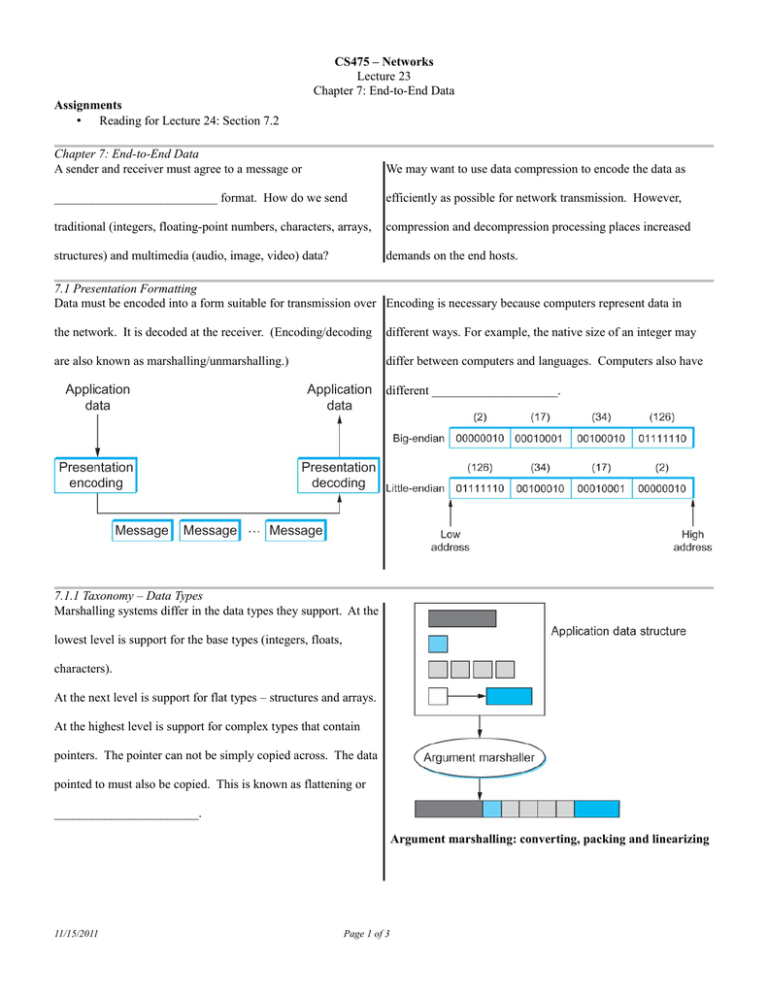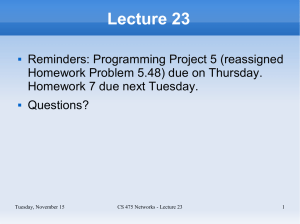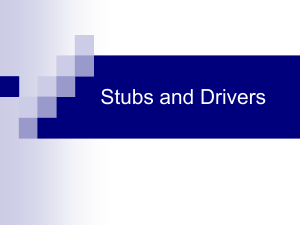CS475 – Networks Assignments Lecture 23 Chapter 7: End-to-End Data
advertisement

CS475 – Networks Lecture 23 Chapter 7: End-to-End Data Assignments • Reading for Lecture 24: Section 7.2 Chapter 7: End-to-End Data A sender and receiver must agree to a message or We may want to use data compression to encode the data as __________________________ format. How do we send efficiently as possible for network transmission. However, traditional (integers, floating-point numbers, characters, arrays, compression and decompression processing places increased structures) and multimedia (audio, image, video) data? demands on the end hosts. 7.1 Presentation Formatting Data must be encoded into a form suitable for transmission over Encoding is necessary because computers represent data in the network. It is decoded at the receiver. (Encoding/decoding different ways. For example, the native size of an integer may are also known as marshalling/unmarshalling.) differ between computers and languages. Computers also have different ____________________. 7.1.1 Taxonomy – Data Types Marshalling systems differ in the data types they support. At the lowest level is support for the base types (integers, floats, characters). At the next level is support for flat types – structures and arrays. At the highest level is support for complex types that contain pointers. The pointer can not be simply copied across. The data pointed to must also be copied. This is known as flattening or _______________________. Argument marshalling: converting, packing and linearizing 11/15/2011 Page 1 of 3 7.1.1 Taxonomy – Conversion Strategy 7.1.1 Taxonomy – Tags Some systems convert all data to canonical intermediate form. Tags can be sent with the data to indicate the type and length of a For example a system may require that all integers be sent in data item. A tag can also be used to indicate the endianess of the big-endian regardless of the endianess of either the source or data in a receiver-makes-right system. receiver. If tags are not used then the receiver must be programmed to The alternative approach is ____________________________ expect data of a particular type in a particular order. in which the sender transmits data in its native form. The receiver is responsible for translating the data to its own local A 32-bit integer encoded in a tagged message form. 7.1.1 Taxonomy – Stubs Stubs are typically used to implement argument marshalling in support of ______________. They may be either compiled or interpreted. Compiled stubs are more efficient while interpreted stubs are more flexible. Interpreted stubs translate data according to a data description file. Changing the data description file does not require recompilation. A stub compiler produces stubs from an interface description. 7.1.2 Examples - XDR External Data Representation (XDR) is used with SunRPC for argument _________________________. • It supports the entire C type system except for function pointers. Example XDR encoding of a structure containing a 32-bit • It uses a canonical intermediate form. integer, a 7 character string, and a 3 element 32-bit integer • It does not use tags (except to indicate array lengths) • It uses compiled stubs. 11/15/2011 Page 2 of 3 array. 7.1.2 Examples - ASN.1 Abstract Syntax Notation One (ASN.1) is an ISO standard that defines a representation (the Basic Encoding Rules or BER) for ASN.1/BER encoding of a 32-bit integer. The value is preceded data sent over a network. It supports all C types except function pointers, uses a canonical by TYPE and LENGTH tags. intermediate form, and it uses tags. The stubs can be either compiled or interpreted. ASN.1/BER LENGTH tags can be of variable size. If the data Compound types (structures) can be created by means of item is less than 128 bytes in length, the LENGTH tag is a single ___________________ in ASN.1/BER. byte. If the data item is longer than 127 bytes, that LENGTH tag is multiple bytes long. The MSB of the leading byte is one. The remaining 7 bits indicate the length of the LENGTH tag. 7.1.2 Examples - NDR Network Data Representation (NDR) uses receiver makes right. NDR inserts an __________________________ tag (shown It supports the C type system. Data items are not tagged. below) at the front of each message so that the receiver knows Compiled stubs are generated from the Interface Description how to translate the data from source format to a local format. Language (IDL). 7.1.3 Markup Languages (XML) In XML all data are tagged and represented using text. The XML data types and compound data type formats are <?xml version=”1.0”?> <employee> <name>John Doe</name> <title>Head Bottle Washer</title> <id>123456789</id> <hiredate> <day>5</day> <month>June</month> <year>1986</year> </hiredate> </employee> defined in an XML Schema Definition (XSD) file. XSDs are also written in XML. XML messages are easy to read and edit. They are naturally ___________________ between architectures. They are inefficient (compared to binary representations of data) and slow to parse. In Class Exercise Write a C++ program that writes your name (first and last network to another computer. Simulate this by copying the names), your age (as an integer) and the first 5 digits of pi memory block to a new location (using memcpy) and then have (3.1415) to memory using XDR (refer to the xdr man page). your program read the values from the new location and display Normally this block of memory would then be sent across the them to standard output. Email program to instructor by Thurs. 11/15/2011 Page 3 of 3





